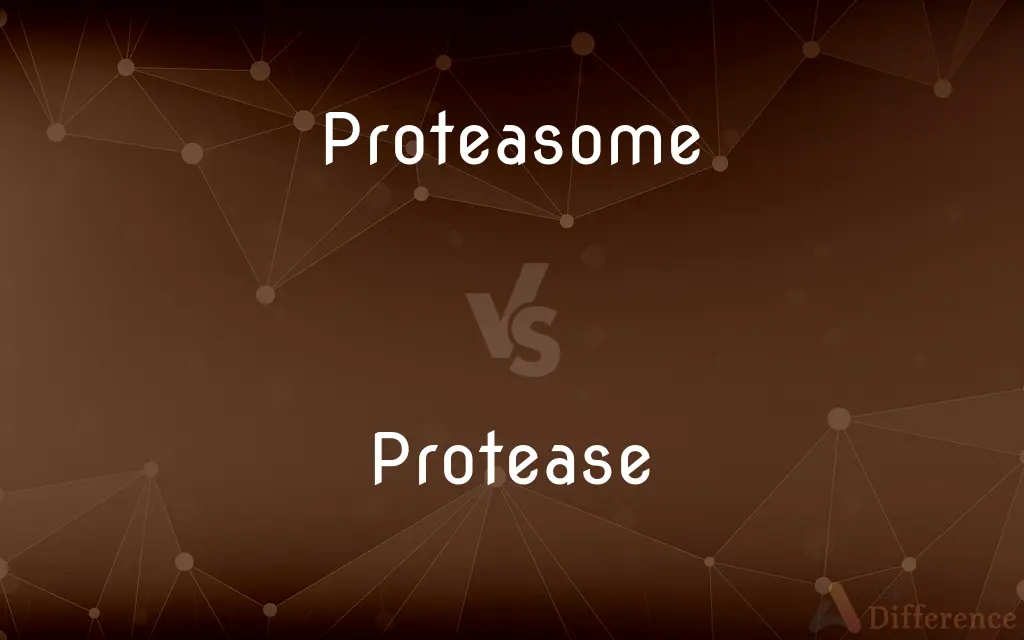Proteasome vs. Protease — What's the Difference?
Edited by Tayyaba Rehman — By Fiza Rafique — Updated on March 14, 2024
Proteasomes are complex protein assemblies that degrade unneeded or damaged proteins by proteolysis, while proteases are enzymes that break down proteins into smaller peptides or amino acids.

Difference Between Proteasome and Protease
Table of Contents
ADVERTISEMENT
Key Differences
Proteasomes are cellular complexes that manage the degradation and recycling of proteins within the cell, ensuring protein quality control and regulating protein levels. On the other hand, proteases are a broad category of enzymes that catalyze the cleavage of peptide bonds in proteins and peptides, playing crucial roles in various biological processes, including digestion and cell signaling.
Proteasomes function as part of the ubiquitin-proteasome system, where proteins are tagged for degradation with a small protein called ubiquitin before being processed by the proteasome. Whereas proteases can act independently, targeting specific peptide bonds within proteins or peptides based on their substrate specificity.
Proteasomes are highly selective in their activity, requiring proteins to be tagged with multiple ubiquitin molecules for recognition. In contrast, proteases vary widely in their specificity, with some cleaving proteins at very specific sequences, while others have broader substrate ranges.
Proteasomes are primarily located within the cytoplasm and nucleus of eukaryotic cells, playing a key role in controlling the concentration of specific proteins and thus regulating cellular processes. Proteases, however, are found in various cellular compartments and extracellularly, involved in numerous physiological processes including digestion, immune response, and clotting.
The activity of proteasomes is essential for the removal of damaged or misfolded proteins, preventing the accumulation of such proteins which can lead to diseases like Alzheimer's and Parkinson's. Proteases, on the other hand, are involved in processing proteins into their functional forms, activating or deactivating proteins as needed for normal cellular function and response to environmental changes.
ADVERTISEMENT
Comparison Chart
Function
Degrades unneeded/damaged proteins
Breaks down proteins into peptides/amino acids
Mechanism
Requires ubiquitin tagging
Acts on specific peptide bonds
Location
Cytoplasm and nucleus
Various, including extracellular spaces
Role in cells
Protein quality control, regulation of protein levels
Diverse, including digestion, immune response
Specificity
Highly selective, requires ubiquitin tag
Varies, from specific to broad substrate range
Compare with Definitions
Proteasome
Located in the cytoplasm and nucleus.
Proteasomes in the nucleus degrade unwanted nuclear proteins.
Protease
An enzyme that cleaves proteins.
The protease broke down the dietary protein into amino acids.
Proteasome
A cellular complex that degrades tagged proteins.
The cell used the proteasome to remove the misfolded protein.
Protease
Can be specific or broad in substrate range.
HIV protease specifically targets viral polypeptides.
Proteasome
Essential for protein quality control.
The proteasome plays a crucial role in removing damaged proteins.
Protease
Found in different cellular compartments.
Lysosomal proteases degrade intracellular proteins.
Proteasome
Part of the ubiquitin-proteasome system.
Ubiquitin tagging is a prerequisite for proteasome-mediated degradation.
Protease
Involved in various biological processes.
Proteases are crucial for clotting and immune responses.
Proteasome
Selective in activity.
The proteasome selectively degrades proteins marked for destruction.
Protease
Plays a role in protein activation.
The protease activated the zymogen by cleaving it.
Proteasome
Proteasomes are protein complexes which degrade unneeded or damaged proteins by proteolysis, a chemical reaction that breaks peptide bonds. Enzymes that help such reactions are called proteases.
Protease
A protease (also called a peptidase or proteinase) is an enzyme that catalyzes (increases the rate of) proteolysis, the breakdown of proteins into smaller polypeptides or single amino acids. They do this by cleaving the peptide bonds within proteins by hydrolysis, a reaction where water breaks bonds.
Proteasome
A cellular protein complex consisting of proteolytic enzymes that degrade endogenous proteins, especially those that are damaged, pathogenic, or no longer of use.
Protease
Any of various enzymes, including the endopeptidases and exopeptidases, that catalyze the hydrolytic breakdown of proteins. Also called peptidase.
Proteasome
(biochemistry) A complex protein, found in bacterial, archeal and eukaryotic cells, that breaks down other proteins via proteolysis.
Protease
(enzyme) An enzyme that cuts or cleaves proteins.
Protease
Any enzyme that catalyzes the splitting of proteins into smaller peptide fractions and amino acids by a process known as proteolysis
Common Curiosities
What is a proteasome?
A proteasome is a complex that degrades unneeded or damaged proteins within the cell.
How do proteasomes recognize their substrates?
Proteasomes recognize proteins tagged with ubiquitin molecules for degradation.
Where are proteasomes found within the cell?
Proteasomes are primarily found in the cytoplasm and nucleus of eukaryotic cells.
What is a protease?
A protease is an enzyme that breaks down proteins into smaller peptides or amino acids.
How do proteases contribute to immune responses?
Proteases are involved in processing and presenting antigens, and activating immune cells.
Can proteases degrade any type of protein?
While proteases can degrade a wide range of proteins, their ability to cleave specific proteins depends on their substrate specificity.
What role do proteasomes play in disease?
Malfunctioning proteasomes can lead to the accumulation of damaged proteins, contributing to diseases like Alzheimer's.
Are all proteases specific to certain proteins?
Proteases vary in specificity; some are highly specific, while others have a broader substrate range.
Is the activity of proteasomes essential for cell health?
Yes, proteasome activity is crucial for maintaining protein quality control and preventing disease.
Can proteases function outside of cells?
Yes, proteases can function extracellularly, such as in digestion and clotting.
Are there inhibitors for proteasomes and proteases?
Yes, specific inhibitors exist for both proteasomes and proteases, some of which are used in therapeutic contexts.
Do proteasomes exist in prokaryotes?
Proteasome-like structures exist in some prokaryotes, but they are more complex and well-defined in eukaryotes.
How do cells regulate proteasome activity?
Cells regulate proteasome activity through mechanisms such as ubiquitin tagging and regulatory proteins.
How are proteases involved in protein activation?
Proteases can activate proteins by cleaving specific peptide bonds, changing the protein's structure and function.
How do proteasomes and proteases differ in their approach to protein degradation?
Proteasomes require a tagging system for protein degradation, while proteases directly cleave peptide bonds within proteins.
Share Your Discovery

Previous Comparison
Prawn vs. Crayfish
Next Comparison
Clam vs. OysterAuthor Spotlight
Written by
Fiza RafiqueFiza Rafique is a skilled content writer at AskDifference.com, where she meticulously refines and enhances written pieces. Drawing from her vast editorial expertise, Fiza ensures clarity, accuracy, and precision in every article. Passionate about language, she continually seeks to elevate the quality of content for readers worldwide.
Edited by
Tayyaba RehmanTayyaba Rehman is a distinguished writer, currently serving as a primary contributor to askdifference.com. As a researcher in semantics and etymology, Tayyaba's passion for the complexity of languages and their distinctions has found a perfect home on the platform. Tayyaba delves into the intricacies of language, distinguishing between commonly confused words and phrases, thereby providing clarity for readers worldwide.














































